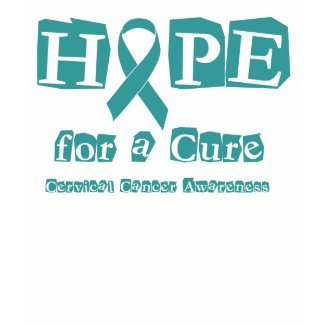January is Cervical Cancer Awareness month in the USA and Australia - a "sister" cancer to ovarian cancer in that it's a member of the gynaecological cancer family. It differs vastly from ovarian cancer as it is readily detectable and often preventable. If caught at an early stage, it's curable.
Cervical cancer is detectable by the Pap test which highlights cell abnormalities and allows for early treatment. According to the National Cervical Cancer Coalition, most women whose cells progress to cervical cancer have not had a Pap test in the previous 3 to 5 years. The majority of these women are 35-55 years old. There are two main types of cervical cancer - adenocarcenoma of the cervix and squamous cell carcenoma. Certain studies report the former to be much more aggressive than squamous cell - which is the more common (80%) of the two.
Two types of Human Papillomavirus (HPV) are found in 99% of cervical cancers. HPV is considered the most common sexually transmitted infection in the US. For 90% of women, this infection clears up on its own within two years. Those subject to persistent infection have a higher risk of developing abnormal cells. Other risk factors include - high parity (large number of live births), smoking and multiple sex partners. A publication in the Lancet 2002 states that there is solid evidence that long-term use of oral contraceptives is associated with 3-4 times increased risk of cervical cancer. Long-term is defined as 5-9 years (3 times the risk) and 10 years plus (4 times the risk).
As stated above, the best and simplest way of detecting cervical cancer is with a Pap test. Secondarily, an HPV test may be recommended. Symptoms of cervical cancer can include abnormal bleeding, pelvic pain not related to your period, increased urinary frequency, unusual discharge and pain during urination.Today, there is an HPV vaccine available which is said to have a 70-80% effectiveness in preventing cervical cancer. Many States in the US and most Provinces in Canada encourage and/or require girls to be immunised before starting Middle School or High School. This is not without controversy. All inoculations have a potential for side effects. However, the bigger issue seems to be one of morality. In certain views, the vaccine is regarded as a green light for sexual permissiveness in teens.
Caught at an early stage, cervical cancer is often treated with surgery and perhaps pelvic radiation. The protocol for advanced cervical cancer includes the use of chemotherapy and radiation therapy after a radical hysterectomy and lymphadenectomy. Recurrent cervical cancer lesions can be re-treated with radiation and chemotherapy with a very poor prognosis.
On a personal note, we have a family member who is in palliative care - at the end stage of her struggle with cervical cancer. As a nurse, she followed all the rules but sadly ended up with the short straw. She is accepting, courageous and at peace. One of my girlfriends has an Irish grandmother who would say "her place in heaven is assured".
Awareness and prevention of this dreaded disease is everything. Absent overt signs and symptoms, women up to the age of 70 are encouraged, even after having been vaccinated, to have a Pap test at least every 3 years.


1 comment:
Thanks for this post. Three years ago at this time I was undergoing treatment for StageIIb Cervical Cancer. I hadn't had a PAP smear for about 5 years prior to the appearance of symptoms. I had aggressive radiation ( exterior and interior) and chemo, and am so far cancer free.
Women really do need to know that they must keep getting PAP smears , even after they are in their sixties and seventies, even after years of celibate living.
Post a Comment